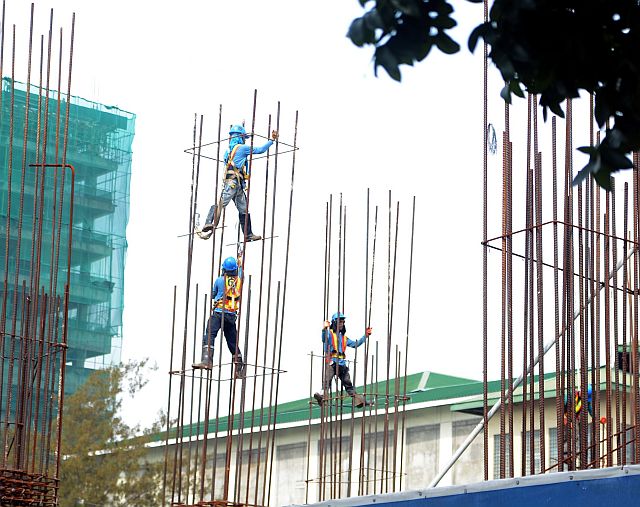
Construction workers work on a building in Cebu City in this 2015 photo. According to National Economic Development Authority Central Visayas Director Efren Carreon, infrastructure build-up may pump prime the recovery of the region’s economy from the COVID-19 crisis. | CDND File Photo
CEBU CITY, Philippines — Infrastructure build-up and maximizing the potentials of the agriculture sector in Central Visayas may be the region’s passport to economic recovery from the effects of the COVID-19 pandemic.
National Economic and Development Authority in Central Visayas (NEDA-7) chief Efren Carreon, in a statement, said the agency maintains a positive outlook for the region’s gradual economic recovery.
Carreon said recovery must be anchored on infrastructure developments to attract more investors in the region in the post-crisis era.
“We will rebound with our infrastructure projects in place and the plan for mass transport system, which should enhance our attractiveness to foreign companies,” Carreon said.
According to NEDA, the region’s strategic location and accessibility through the Mactan Cebu International Airport (MCIA), coupled with the ongoing and lined up projects may attract more foreign investments “especially those leaving China post-pandemic.”
“We have a modern airport. Metro Cebu Expressway is on the pipeline. Our new container port is about to commence later this year. Other airports and seaports in the region have also been upgraded,” Carreon explained.
Taking into account the experience from the COVID-19 pandemic, Carreon said he sees more opportunity for the agriculture sector which has proven to be very essential during the months-long lockdown.
Efren Carreon, National Economic Development Authority in Central Visayas (Neda-7) chief. (CDN DIGITAL FILE PHOTO_
“That’s the opportunity there. Our agri-fishery sector currently contributes about 5 percent to our economy. But there’s so much potential. We need to invest more into the sector to increase production,” he said.
In Cebu province, Governor Gwendolyn Garcia earlier said the provincial government is working on an “enhanced countryside development” (ECD) initiative to promote self-sufficiency in food production.
Read: Capitol to focus on Enhanced Countryside Development after ECQ is lifted
Although Region 7’s economy is projected to start its recovery during the second half of the year, the NEDA-7 chief said the growth rate may not be as robust as what was observed in 2019 when there was no community quarantine in place.
Cebu City, which is the center of trade here, remains under a modified enhanced community quarantine (MECQ) at least until July 31.
The highly urbanized cities of Mandaue and Lapu-Lapu, whose economies are anchored on manufacturing and export industries, are under a more relaxed general community quarantine.
Cebu province, except for the city of Talisay and the municipalities of Minglanilla and Consolacion, and the provinces of Bohol, and Negros Oriental are under a moderate risk modified general community quarantine while the island province of Siquijor, which remains COVID-19 free, is under a low-risk MGCQ.
Meanwhile, Carreon also said that the tourism industry, which is considered as a primary economic driver in the region, may start to recover within the end of 2020 until around the early part of 2022.
NEDA pegs the tourism sector, which is among the worst-hit sectors during the pandemic, to have incurred losses of about P12.5 billion in the first quarter of 2020 alone because of the travel restrictions and the community quarantine implementation.
The first quarter tourism losses cover accommodation facilities, including hotels and resorts, which recorded the biggest foregone revenue at P5.5 billion, followed by restaurants at P4.7 billion, retail at P1.9 billion, and the transport sector at P876 million.
Read: Tourism industry pegs P25B loss due to COVID-19
However, Carreon projected that the services sector, despite the setback from the economic downturn, will continue to dominate the economy in the region.
The provinces of Cebu and Bohol have earlier announced that it will focus on its local tourism market first as the two provinces reopen its tourism industry. / dcb